Oliver Hazard Perry
Oliver Hazard Perry (August 23, 1785 – August 23, 1819) was an American naval commander, born in South Kingstown, Rhode Island. As the best-known and most prominent member of the Perry family naval dynasty, he was the son of Sarah Wallace Alexander and United States Navy Captain Christopher Raymond Perry, and older brother of Commodore Matthew C. Perry.
Oliver Hazard Perry | |
|---|---|
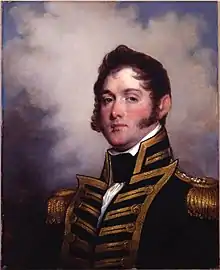 The Hero of Lake Erie | |
| Born | August 23, 1785 South Kingstown, Rhode Island, United States |
| Died | August 23, 1819 (aged 34) Trinidad |
| Place of burial | |
| Allegiance | |
| Service/ | |
| Years of service | 1799–1819 |
| Rank | Commodore |
| Commands held |
|
| Battles/wars | |
| Awards | Congressional Gold Medal |
| Relations |
|
Perry served in the West Indies during the Quasi War of 1798–1800 against France, in the Mediterranean during the Barbary Wars of 1801–1815, and in the Caribbean fighting piracy and the slave trade, but is most noted for his heroic role in the War of 1812 during the 1813 Battle of Lake Erie.[1] During the war against Britain, Perry supervised the building of a fleet at Erie, Pennsylvania. He earned the title "Hero of Lake Erie" for leading American forces in a decisive naval victory at the Battle of Lake Erie, receiving a Congressional Gold Medal and the Thanks of Congress.[2][3] His leadership materially aided the successful outcomes of all nine Lake Erie military campaign victories, and the victory was a turning point in the battle for the west in the war.[3] He is remembered for the words on his battle flag, "Don't Give Up the Ship", which was a tribute to the dying command of his colleague Captain James Lawrence of USS Chesapeake. He is also known for his message to General William Henry Harrison which reads in part, "We have met the enemy and they are ours; ..."
Perry became embroiled in a long-standing and bitter controversy with the commander of USS Niagara, Captain Jesse Elliott, over their conduct in the Battle of Lake Erie, and both were the subject of official charges. In 1815, he successfully commanded Java in the Mediterranean during the Second Barbary War. So seminal was his career that he was lionized in the press (being the subject of scores of books and articles).[4] He has been frequently memorialized, and many places, ships and persons have been named in his honor.
Childhood and early life
As a boy, Perry lived in Tower Hill, Rhode Island,[5] sailing ships in anticipation of his future career as an officer in the United States Navy.[3] He was the oldest of five boys born to Christopher and Sarah Perry. Perry came from a long line of accomplished naval men from both sides of his family. His mother taught Perry and his younger brothers to read and write and had them attend Trinity Episcopal Church regularly, where he was baptized by Reverend William Smith on April 1, 1794, at the age of nine. Reverend Theodore Dehon, rector of the church from 1797 to 1810, had a significant influence on the young Perry.[6] He was educated in Newport, Rhode Island.
Early naval career
Through his father's influence, Perry was appointed a midshipman in the United States Navy, at the age of thirteen, on April 7, 1799. Perry sailed aboard USS General Greene, of which his father was commanding officer, on her maiden voyage in June 1799. The ship made its first stop in Cuba, charged with receiving American merchant ships and providing escort from Havana to the United States.[3][7] Perry's service aboard General Greene continued during the Quasi-War with France.[8] He first experienced combat on February 9, 1800, off the coast of the French colony of Haiti, which was in a state of rebellion.[9][10]
During the First Barbary War, he served aboard USS Adams[11] and later was first lieutenant (second in command) of USS Nautilus. He then served under Captain John Rodgers on USS Constitution and USS Essex. He was placed in charge of construction of gunboats in Newport and Westerly, Rhode Island.
Beginning in April 1809, he commanded the sloop USS Revenge, engaging in patrol duties to enforce the Embargo Act, as well as a successful raid to regain an American ship held in Spanish territory in Florida. On January 9, 1811, Revenge ran aground off Rhode Island and was lost. "Seeing fairly quickly that he could not save the vessel, [Perry] turned his attention to saving the crew, and after helping them down the ropes over the vessel's stern, he was the last to leave the vessel."[12]:61 The subsequent court-martial exonerated Perry, placing blame on the ship's pilot.[upper-alpha 1][13] In January 2011, a team of divers claimed to have discovered the remains of Revenge, nearly 200 years to the day after it sank.[14][15] Cannons from Revenge were salvaged by the U.S. Navy in 2017.
Following the court-martial, Perry was given a leave of absence from the Navy. On May 5, 1811, he married Elizabeth Champlin Mason of Newport, Rhode Island, whom he had met at a dance in 1807.[13] They enjoyed an extended honeymoon touring New England. The couple would eventually have five children, with one dying in infancy.[16]
War of 1812
At the beginning of the War of 1812, the British Royal Navy controlled the Great Lakes, except for Lake Huron, while the United States Navy controlled Lake Champlain.[17] The American naval forces were very small, allowing the British to make many advances in the Great Lakes and northern New York waterways. The roles played by commanders like Perry, at Lake Erie and Isaac Chauncey at Lake Ontario and Thomas Macdonough at Lake Champlain all proved vital to the naval effort. Naval historian E. B. Potter noted that "all naval officers of the day made a special study of Nelson's battles". Oliver Perry was no exception. [18] At his request, he was given command of the American naval forces on Lake Erie during the war. Secretary of the Navy Paul Hamilton had charged prominent merchant seaman Daniel Dobbins with building the American fleet on Presque Isle Bay at Erie, Pennsylvania, and Perry was named chief naval officer.[2][3][19]
Perry knew battle was coming, and he "consciously followed Nelson's example in describing his battle plans to his captains."[18]:218 Perry's instructions were:
Commanding officers are particularly enjoined to pay attention in preserving their stations in the Line, and in all cases to keep as near the Lawrence as possible. ... Engage your designated adversary, in close action, at half cable's length. [upper-alpha 2][20]
— Oliver H. Perry, General Order, USS Lawrence
Hero of Lake Erie
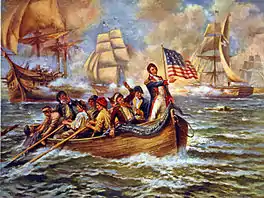
%22_presented_in_cartoon_with_a_historical_preface_from_%22official%22_data_-_DPLA_-_0d0f8c371cbf6d8687013bd10d051e76_(page_18)_(cropped).jpg.webp)
On September 10, 1813, Perry's command fought a successful fleet action against a squadron of the Royal Navy in the Battle of Lake Erie. It was at the outset of this battle that Perry famously said, "If a victory is to be gained, I will gain it."[21] Initially, the exchange of gunfire favored the British. Perry's flagship, USS Lawrence, was so severely disabled in the encounter that the British commander, Robert Heriot Barclay, thought that Perry would surrender it, and sent a small boat to request that the American vessel pull down its flag. Faithful to the words of his battle flag, "DON'T GIVE UP THE SHIP" (a paraphrase of the dying words of Captain James Lawrence, the ship's namesake and Perry's friend),[22][23] Perry, with Lawrence's chaplain and purser as the remaining able crew, personally fired the final salvo,[24] and then had his men row him a half-mile (0.8 km) through heavy gunfire to transfer his command to USS Niagara. Once aboard, Perry dispatched Niagara's commander, Captain Jesse Elliott, to bring the other schooners into closer action while he steered Niagara toward the damaged British ships. Like Nelson's Victory at Trafalgar, Niagara broke the opposing line. Perry's force pounded Barclay's ships until they could offer no effective resistance and surrendered. Although he had won the battle aboard Niagara, he received the British surrender on the deck of the recaptured Lawrence to allow the British to see the terrible price his men had paid.[21] Perry's battle report to General William Henry Harrison was famously brief: "We have met the enemy and they are ours; two ships, two brigs, one schooner and one sloop."[22][upper-alpha 3]

This was the first time in history that an entire British naval squadron had surrendered, and every captured ship was successfully returned to Presque Isle.[25][26]
Although the engagement was small compared to Napoleonic naval battles such as the Battle of Trafalgar, the victory had disproportionate strategic importance, opening Canada up to possible invasion, while simultaneously protecting the entire Ohio Valley.[3][27] The loss of the British squadron directly led to the critical Battle of the Thames, the rout of British forces by Harrison's army, the deaths of Tecumseh and Roundhead, and the breakup of his Indian alliance.[26] Along with the Battle of Plattsburgh, it was one of only two significant fleet victories of the war.[3]
In fact, Perry was involved in nine battles that led to and followed the Battle of Lake Erie, and they all had a seminal impact. "What is often overlooked when studying Perry is how his physical participation and brilliant strategic leadership influenced the outcomes of all nine Lake Erie military campaign victories:
Capturing Fort George, Ontario in the Battle of Fort George; Destroying the British munitions at Olde Fort Erie (see Capture of Fort Erie); Rescuing five vessels from Black Rock; Building the Erie fleet; Getting the ships over the sandbar; Blocking British supplies for a month prior to battle; Planning the Thames invasion with General Harrison; Winning the Battle of Lake Erie; and Winning the Battle of Thames.[3][26]
The Battle Flag
_flies_a_%E2%80%9CDon%E2%80%99t_Give_Up_the_Ship%E2%80%9D_flag._(49966895161).jpg.webp)
"Don't give up the ship", a phrase repeated by Captain James Lawrence during his dying days after being wounded by enemy fire aboard the Chesapeake on June 1, 1813, became the battle cry of Oliver Hazard Perry. Perry learned of Lawrence's demise upon arrival at Presque Isle and commanded that Lawrence would be honored with the name of a brig, which would simply be called Lawrence. A battle flag would also be needed, and the words of Perry's good friend Lawrence would be just the battle cry suited for the coming days. A woman named Margaret Forster Steuart, resident of Erie Pennsylvania, wife of Army Captain Thomas Steuart and sister to Thomas Forster, both friends of Perry's, Forster being commander of the Erie Light Infantry that had guarded the fleet, was enlisted to make the battle flag. With the help of her two daughters, three nieces, and a cousin, she had the flag ready for Perry within just a few days.[28] As of July 2009, Perry's flag, Steuart's work, and Lawrence's dying words can still be seen today, as the flag has been placed on display in Bancroft Hall at the U.S. Naval Academy in Annapolis.
Perry–Elliott controversy

While Nelson had Collingwood, Perry had Jesse Elliott, and was considerably less well served. Elliott, while serving with Isaac Chauncey at Lake Ontario, was tasked to augment Perry's squadron with 11 officers and 91 men, "and none were sent but the worst."[29] Subsequently, detailed by Chauncey to command Niagara, Elliott stated "that if he could have foreseen that he himself should be sent to Lake Erie, his selections would have been different."[29] Elliott then appropriated the "best of the worst" for Niagara; and Perry "in the interest of harmony" accepted the situation, though with growing ill-will.[29]
In his initial post-action report, Perry had praised Captain Elliott's role in the American victory at Lake Erie; and as news of the battle spread, Perry and Elliott were both celebrated as national heroes. Soon after, however, several junior officers publicly criticized Elliott's performance during the battle, charging that Elliott allowed Lawrence to suffer the brunt of the British fire while holding Niagara back from the fight. William Vigneron Taylor, Perry's sailing master, in a letter to Taylor's wife, put it thus:
The Lawrence alone rec'd the fire of the whole British squadron 2 1/2 hours within pistol shot—we were not supported as we ought to have been. Captain Perry led the Lawrence into action & sustained the most destructive fire with the most gallant spirit perhaps that was ever witnessed under similar circumstances.[30]
— William Taylor, 15 September 1813
The meeting between Elliott and Perry on the deck of Niagara was terse. Elliott inquired how the day was going. Perry replied, "Badly." Elliott then volunteered to take Perry's small boat and rally the schooners, and Perry acquiesced.[20]:49 As Perry turned Niagara into the battle, Elliott was not aboard. Elliott's rejoinder to history's criticism of inaction was that there had been a lack of effective signaling. Charges were filed, but not officially acted upon. Attempting to restore his honor, Elliott and his supporters began a 30-year campaign that would outlive both men and ultimately leave his reputation in tatters.[26]
In Perry's report to Secretary of the Navy William Jones, written three days after the battle, he mentioned Elliott in what, at first, seem to be complimentary terms, but, when read carefully, betray his disdain for Elliott. Perry wrote, "In this action he evinced his characteristic bravery and judgement; and, since the close of the action, has given me the most able and essential assistance."[31]
Congressional Gold Medal
On January 6, 1814, Perry was honored with a Congressional Gold Medal,[32] the Thanks of Congress, and a promotion to the rank of Captain.[33][34] This was one of 27 Gold Medals authorized by Congress arising from the War of 1812.[35]
 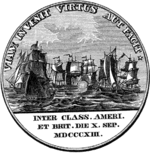 |
|
Elliott was also recognized with a Congressional Gold Medal[32] and the Thanks of Congress for his actions in the battle. This recognition would prove to fan the flames of resentment on both sides of the Elliott–Perry controversy.[26]
In recognition of his victory at Lake Erie, in 1813 Perry was elected as an honorary member of the New York Society of the Cincinnati.
Later commands and controversies
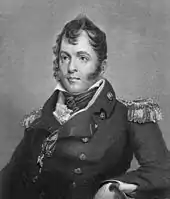
In May 1814, Perry took command of a squadron of seven gunboats based in Newport. He held this command for only two months as in July he was placed in command of USS Java, a 44-gun frigate which was under construction in Baltimore. While overseeing the outfitting of Java, Perry participated in the defenses of Baltimore and Washington, D.C., during the British invasion of the Chesapeake Bay. In a twist of irony, these land battles would be the last time the career naval officer saw combat. The Treaty of Ghent was signed before Java could be put to sea.[16]
For Perry, the post-war years were marred by controversies. In 1815, he commanded Java in the Mediterranean during the Second Barbary War. While moored in Naples, Perry slapped the commander of the ship's Marines, Captain John Heath, whom Perry considered incompetent and insubordinate. The ensuing court-martial found both men guilty, but levied only mild reprimands. After the crew returned home, Heath challenged Perry to a pistol duel, which was fought on October 19, 1817, on the same field in Weehawken, New Jersey where Aaron Burr shot and killed Alexander Hamilton. Heath fired first and missed. Perry declined to return fire, satisfying the Marine's honor.[16]
Perry's return from the Mediterranean also reignited the feud with Elliott. After an exchange of angry letters, Elliott challenged Perry to a duel, which Perry refused. (While it was normally considered cowardly to refuse a duel, Perry's stature as a hero was such that no one doubted his physical courage and few felt that Perry had wrongly offended Elliott's honor.) He instead, on August 8, 1818, filed formal court-martial charges against Elliott. Perry filed a total of six charges and twenty-one specifications including "conduct unbecoming an officer," and failure to "do his utmost to take or destroy the vessel of the enemy which it was his duty to encounter."
Wishing to avoid a scandal between two decorated naval heroes, Secretary of the Navy Smith Thompson and President James Monroe suppressed the matter by offering Perry a diplomatic mission to South America in exchange for dropping his charges. This put an official end to the controversy, though it would continue to be debated for another quarter century.[38]
Mission to Venezuela and death
In 1818 Perry purchased a large house on Washington Square in Newport which was built in 1750 for merchant Peter Buloid. The house remained in the Perry family until 1865 and now serves as an antique bookstore.
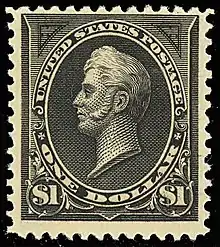

In 1819, Perry sailed for the Orinoco River, Venezuela, aboard of the frigate John Adams with the frigate Constellation and the schooner USS Nonsuch, arriving on July 15 to discourage piracy, while still maintaining friendly relations with Republic of Venezuela and the Republic of Buenos Aires. Shifting his flag to USS Nonsuch, due to its shallower draft, Perry sailed upriver to Angostura to negotiate an anti-piracy agreement with President Simón Bolívar. A favorable treaty was signed on August 11 with Vice-President Francisco Antonio Zea in the absence of Bolivar (who was engaged in the liberation of New Granada), but when the schooner started downriver, many of her crew, including Perry, had been stricken with yellow fever.
Despite the crew's efforts to reach Trinidad for medical assistance, the commodore died on board USS Nonsuch on August 23, 1819, his 34th birthday, as the ship entered the Gulf of Paria and was nearing Port of Spain.[39] He was buried in Port of Spain with great honors while the Nonsuch's crew acted as honor guard.
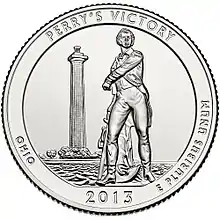
His remains were later taken back to the United States in 1826 and interred in Newport, Rhode Island. Originally interred in the Old Common Burial Ground, his body was eventually moved to Newport's Island Cemetery.[40]
Family
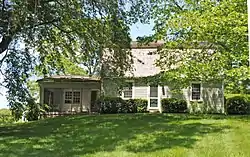
Perry's parents were Christopher Raymond Perry (1761–1818), who was also born in South Kingstown, Rhode Island, and Sarah Wallace Alexander (1763–1830). Through his mother, Perry was a direct descendant of the uncle of Scottish nobleman and military leader William Wallace[2] (d. 1305), whose life was the inspiration for the movie Braveheart.
Perry married Elizabeth Champlin Mason in 1811. They had five children, four of whom lived to maturity. They were:
- Brigadier General Christopher Grant Champlin Perry, RIM (April 2, 1812 – April 5, 1854), commander of the Artillery Company of Newport from 1845-1854, m. Murial Frances Sergeant of Philadelphia (great-granddaughter of Benjamin Franklin); their daughter Margaret Mason Perry married the artist John LaFarge;
- Oliver Hazard Perry II (February 23, 1813 – March 4, 1814), died in infancy;
- Lieutenant Oliver Hazard Perry, Jr., USN (February 23, 1815 – August 20, 1878), m. 1) Elizabeth Ann Randolph (1816–1847) (Virginia Randolph family) and m. 2) Mary Ann Moseley;
- First Lieutenant Christopher Raymond Perry, USA (June 29, 1816 – October 8, 1848), never married;
- Elizabeth Mason Perry, m., as his 2nd wife, the Reverend Francis Vinton, rector of Trinity Episcopal Church in Newport.
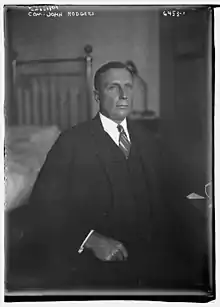
Perry's son Christopher Grant Champlin Perry was a physician, and served as commander of the Artillery Company of Newport from April 1848 until his death in 1854. In May 1849 he was commissioned as a brigadier general in the Rhode Island Militia and given command of the 1st Brigade encompassing Newport and Bristol Counties.[41]
Perry's son Oliver Hazard Perry, Jr. entered the Navy as a midshipman in 1829, rose to the rank of lieutenant and resigned in 1849. He served on the United States Exploring Expedition under Captain Charles Wilkes from 1839 to 1842. Although he is buried in the same cemetery as his parents, for unknown reasons, he is not buried in the same plot with his parents.
Perry's son Christopher Raymond Perry graduated from the United States Military Academy at West Point in 1842. He served during the Mexican War and fought at the Battle of Palo Alto on May 8, 1846, and at the Battle of Resaca-de‑la‑Palma on May 9, 1846. He died on active duty as a 1st lieutenant in 1848.[42]
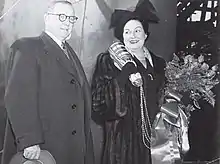
His extended family's descendants include Commander John Rodgers, the second person to become a United States naval aviator, and well known civilian aviator Calbraith Perry Rodgers, the first person to fly an airplane—the Vin Fiz—across the United States.[43]
Perry's nephew by marriage, George Champlin Mason, Sr., was a noted architect and historian.
Oliver Hazard Perry La Farge (December 19, 1901 – August 2, 1963), Perry's great-great-grandson and namesake, was an American writer and anthropologist, best known for his 1930 Pulitzer Prize–winning novel Laughing Boy.
His great-grandnephew Oliver Hazard Perry Belmont (November 12, 1858 – June 10, 1908) from Buffalo, NY was an American socialite and United States Representative from New York.
Perry's great-grandniece, Ruth Black (November 1893 – September 3, 1964), married Gulf Oil executive Willard F. Jones.[44][45]
Oliver Hazard Perry Throck Morton (August 4, 1823 – November 1, 1877) (no relation)—the 14th Governor of Indiana, a famous Republican politician and U.S. Senator, who was a leader among the Radical Republican reconstructionists—was named in his honor.[46]
Dates of rank
- Midshipman – 7 April 1799
- Lieutenant – 15 January 1807
- Master Commandant – 28 August 1812
- Captain – 10 September 1813
Although Perry is often referred to as "Commodore Perry," it should be kept in mind that, prior to the American Civil War, commodore was not a rank in the U.S. Navy but, rather, the title of an officer in command of a squadron of two or more ships. Perry first held the title of commodore when he took command of the Lake Erie squadron in 1813.
Assignments
- Midshipman, USS General Greene – April 1799 to May 1801
- Acting Lieutenant, USS Adams – June 1802 to November 1803
- Second Lieutenant, USS Constellation – May 1804 to July 1805
- First Lieutenant, USS Nautilus – July 1805 to December 1805
- Acting Lieutenant, USS Constitution – December 1805 to c. July 1806
- Second Lieutenant, USS Essex – c. July 1806 to c. October 1806
- Officer in Charge of Gunboat construction in Newport and Westerly, RI – October 1806 to April 1809
- Commanding Officer, USS Revenge – April 1809 to January 1811
- Commanding Officer, Gunboat Squadron, Newport, RI – c. 1811 to January 1813
- Commanding Officer, Lake Erie Squadron – March 1813 to c. October 1813
- Commanding Officer, Gunboat squadron, Newport, RI – May 1814 to July 1814
- Commanding Officer, USS Java (under construction) – July 1814 to August 1815
- Commanding Officer, USS Java (in commission) – August 1815 to c. May 1817
- Senior Naval Officer, Newport, RI – c. May 1817 to May 1819
- Commanding Officer, Venezuelan diplomatic mission – June 1819 to August 1819 (deceased)
Note – Time gaps between assignments were probably in a "waiting orders" status.
Geographical namesakes
Many locations, both in Rhode Island and near Lake Erie, are named in his honor, including:
- Perry Elementary School, Erie, PA
- Commodore Perry School District, including Perry Township, Mercer County, Pennsylvania
- Oliver Hazard Perry Middle School, Providence, RI
- Training Ship Oliver Hazard Perry, Newport, RI
- All of the ten Perry counties in the U.S.
- Perryville and Perry County, Missouri
- The hamlet of Perrysburg and the surrounding township; and the Village of Perry, New York and the surrounding township,[47]
- The city of Perry, Georgia
- The town of Perry, Maine
- The village of Perry, Illinois
- The cities of Perrysburg,[upper-alpha 4] Perrysville, North Perry and Perry; Perrysburg Township; and Perry County, Ohio.
- The unincorporated hamlet of South Perry, in Perry Township, Hocking County, Ohio.
- Perry Township, between Canton and Massillon in Stark County, Ohio. The local high school is also named in his honor.
- The borough of Perryopolis and Oliver Township, within Perry County, and Oliver Township and Perry Township in Jefferson County, Pennsylvania.[48]
- The village of Perryville in the town of South Kingstown, Rhode Island. The portion of U.S. Route 1 near Perryville is named the Commodore Oliver Hazard Perry Highway. Perry Street in Newport is also named after him.[49]
- The City of Hazard in Perry County, Kentucky.[50]
- Perry County, Tennessee
- Perry Street, New York
- Fort Perry in Box Springs, Georgia
An eastbound service plaza along the Ohio Turnpike is named the Commodore Perry Service Plaza, located in Sandusky County, Ohio.[51]
Monuments
The national monument commemorating Perry is the Perry's Victory and International Peace Memorial at Put-In-Bay, Ohio. Its 352 ft (107 m) tower, the world's most massive Doric column, was constructed by a multi-state commission between 1912 and 1915.[52]
Other monuments include:
- Memorial plaque, Trinity Episcopal Church, Newport, Rhode Island, dedicated by Perry's widow on August 23, 1855, the 36th anniversary of his death.[53]
- Perry Monument, Public Square, Cleveland, Ohio, monument and statue by William Walcutt, dedicated on September 10, 1860, the 47th anniversary of the Battle of Lake Erie. Walcutt's marble statue was replaced with a bronze copy in 1929. The monument was relocated to Fort Huntington Park in 1991.
- Walcutt's marble Perry statue is on long-term loan to the Perry's Victory and International Peace Memorial.
- Oliver Hazard Perry by William Greene Turner, Eisenhower Park, Newport, Rhode Island, dedicated September 10, 1885, the 72nd anniversary of the Battle of Lake Erie.[54]
- Oliver Hazard Perry by Charles Henry Niehaus, Front Park, Buffalo, New York, dedicated on September 25, 1916.
- Perry Monument, Perry Square, Erie, Pennsylvania, designed by Paul Philippe Cret, 1925, features a bronze copy after William Greene Turner's 1885 statue.
- Oliver Hazard Perry Memorial Gateway, Port-of-Spain, Trinidad, dedicated April 1925. Captain Henry E. Lackey, the United States Navy representative at the dedication, arrived aboard the newly commissioned light cruiser USS Memphis (CL-13).[55][56]
- Perry Monument at Misery Bay, Presque Isle State Park, Erie, Pennsylvania, dedicated in 1926.
- Oliver Hazard Perry (bronze copy after William Walcutt), on the south front of the Rhode Island State House, Providence, Rhode Island, dedicated in 1928.
- Perry Monument, Perrysburg, Ohio, dedicated in 1997, features a bronze copy after William Walcutt's 1860 statue.
- The reverse of the 2013 "Perry's Victory" quarter shows William Walcutt's statue of Perry (1860) with the Perry's Victory and International Peace Memorial in the distance.[57]
- The family farm in South Kingstown, where Perry was probably born and later built a house, was listed on the National Register of Historic Places in 1982.[58]
- A larger than life portrait of Commodore Perry hangs in the Executive Chamber of the Rhode Island State House.
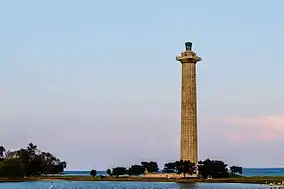 Perry's Victory and International Peace Memorial (1912–1915), Put-In-Bay, Ohio
Perry's Victory and International Peace Memorial (1912–1915), Put-In-Bay, Ohio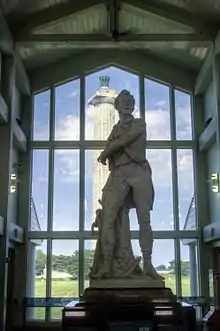 Oliver Hazard Perry (1860), by William Walcutt, Perry's Victory and International Peace Memorial
Oliver Hazard Perry (1860), by William Walcutt, Perry's Victory and International Peace Memorial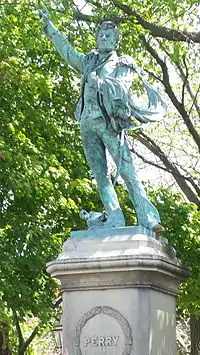 Oliver Hazard Perry (1885), by William Greene Turner, Newport, Rhode Island
Oliver Hazard Perry (1885), by William Greene Turner, Newport, Rhode Island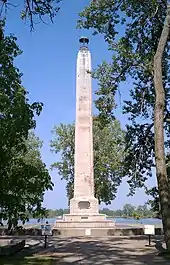 Perry Monument (1926), Presque Isle, Erie, Pennsylvania
Perry Monument (1926), Presque Isle, Erie, Pennsylvania Perry statue (1928), Rhode Island State House
Perry statue (1928), Rhode Island State House
Paintings

- Perry's Victory on Lake Erie (1865) by William Henry Powell, Rotunda, Ohio Statehouse, Columbus.[59] Dimensions: 12 ft × 16 ft (3.7 m × 4.9 m).
- Battle of Lake Erie (1873) by William Henry Powell, United States Capitol, Washington D.C.[60] Dimensions: 16.76 ft × 26.63 ft (5.11 m × 8.12 m).
- Portrait of Oliver Hazard Perry (1900), by Gari Melchers, Executive Chamber, Rhode Island State House.[61]
- Battle of Lake Erie (c. 1911) by Edward Percy Moran.
- Battle of Lake Erie, 10 September 1813. (1959) by Charles Robert Patterson and Howard B. French, United States Naval Academy, Annapolis, Maryland.
Documentary
In 2016, principal photography began on We Have Met the Enemy, a feature-length documentary produced by Lou Reda (Vietnam in HD, The Blue and the Gray), for a planned spring 2017 release.[62]
Eponymous ships
Commodore Perry has been repeatedly honored with ships bearing his name.
- USS Perry (1843), a sailing brig 1843–1865
- USS Commodore Perry (1859), an armed side-wheel ferry built in 1859 by Stack and Joyce, Williamsburg, New York and purchased by the Navy on October 2, 1861; and commissioned later in the month, Acting Master F. J. Thomas was in command[63]
- USS Perry (DD-11), a Bainbridge-class destroyer (1900–1919)
- USS Perry (DD-340), a Clemson-class destroyer converted into a high-speed minesweeper and re-designated DMS–17 effective November 19, 1940. Served 1921–1944; sunk in Battle of Peleliu.
- SS Oliver Hazard Perry, a Liberty ship. See List of Liberty ships (M–R).[64]
- USS Perry (DD-844), a Gearing-class destroyer (1945–1970)
- USS Oliver Hazard Perry (FFG-7), a guided-missile frigate (1976–1997), and the Oliver Hazard Perry-class frigates, of which it was a member, are named in his honor. The Navy built 51 of the Oliver Hazard Perry-class frigates, with the first going into service in 1977, and the last to be finally moth-balled in 2015.[65][66] See also USS Perry.
- SSV Oliver Hazard Perry, a Rhode Island Educational Foundation tall ship
See also
Notes
Footnotes
- His progression from being the subject of a court-martial for running aground to being a formidable commander who made a real difference has a striking parallel to the career of Admiral Chester W. Nimitz.
- A "cable" is 720 feet in the Royal Navy, 600 feet (183 m) in the U.S. Navy. "Half cable's length" would be less than 330 feet (100 m).
- The British order of battle was actually two ships, one brig, two schooners and one sloop.[24]:260–261 "Perry's message was inaccurate." [20]:Note 129, p. 97.
- There is a monument of him on the river near the PYC (Perrysburg Yacht Club). This town also is the home of Fort Meigs
Citations
- Skaggs, 2006, p. xi
- White, 1895, p. 288
- Bloom, Page essay
- Paullin, 1918, See Bibliography
- Capace, Nancy (May 1, 2001). The Encyclopedia of Rhode Island. St. Clair Shores, Michigan: Somerset Publishers, Inc. p. 368. ISBN 978-0403096107. Retrieved August 23, 2014.
- Skaggs, 2006, p. 6
- Mackenzie, 1840, p. 40
- Barnes, 1912, p. 11
- Brown, 2006, Oliver Hazard Perry, p. 226
- Barnes, 1912, p. 16
- Mackenzie, 1840, pp. 53–55
- Copes, Jan M. (Fall 1994). "The Perry Family: A Newport Naval Dynasty of the Early Republic". Newport History: Bulletin of the Newport Historical Society. Newport, RI: Newport Historical Society. 66, Part 2 (227): 49–77.
- Cooper, James Fenimore (May 1843). Oliver Hazard Perry. XXII. Graham's Magazine. p. 268. Retrieved January 7, 2011.
- "Divers: 1811 Wreck of Perry Ship Discovered Off RI". The New York Times. Associated Press. January 7, 2011. Retrieved January 7, 2011.
- "Divers Say They've Found 1811 Wreck of Perry Ship". AOL News. January 8, 2011. Archived from the original on January 9, 2011. Retrieved January 9, 2011.
- "Oliver Hazard Perry – Perry's Victory & International Peace Memorial". Retrieved June 9, 2012.
- Skaggs, 2006, p. 50
- Potter, 1981, p. 106
- Herring, James; Longacre, James Barton (1854). The national portrait gallery of distinguished Americans. 1. Philadelphia: D. Rice & A.N. Hart. Retrieved September 3, 2011.
- Altoff, Gerard T. (1999). Oliver Hazard Perry and the Battle of Lake Erie. Put-in-Bay, OH: The Perry Group. ISBN 978-1887794039.
- Farmer, Silas. (1884) (Jul 1969) The history of Detroit and Michigan, or, The metropolis illustrated: a bepis cyclopaedia of the past and present: including a full record of territorial days in Michigan, and the annuals of Wayne County, p. 283 and Various formats at Open Library.
- "Famous Navy Quotes: Who Said Them and When". Naval History and Heritage Command. Archived from the original on September 23, 2007. Retrieved September 3, 2011.
- Dudley, William S., ed. The Naval War of 1812: A Documentary History. vol.2 (Washington, D.C.: US Government Printing Office, 1992), p. 559.
- Roosevelt, Theodore (1889). The Naval War of 1812 Or The History of the United States Navy during the Last War with Great Britain to Which Is Appended an Account of the Battle of New Orleans (Tenth ed.). New York: G. P. Putnum's Sons. p. 266.
- Skaggs, 2000, p. 147
- Skaggs, David Curtis (April 2009). "Perry Triumphant". Naval History Magazine. United States Naval Institute. 23 (2). Retrieved September 3, 2011.
- Symonds, Craig L; Clipson, William J. (April 2001) The Naval Institute historical atlas of the U.S. Navy Annapolis, Maryland: Naval Institute Press 264 pp, ISBN 978-1-55750-984-0, p. 48.
- Skaggs, David Curtis (2013). The Battle of Lake Erie and Its Aftermath. Ohio: The Kent State University Press. p. 220.
- Quoted in Altoff, Gerard T. (1993). Deep Water Sailors Shallow Water Soldiers: Manning the United States Fleet on Lake Erie – 1813. Put-in-Bay, OH: The Perry Group. pp. 23–24. ISBN 978-1887794015.
- Taylor, William V. (1813). Logbook of the USS Lawrence. Newport, RI: Newport Historical Society.
- American State Papers. Naval Affairs. Volume 1. pg. 295.
- J. F. Loubat, LL.D. (1831–1927) (1888). The Medallic History of the United States of America, 1776—1876. Volume II. Illustrated by Jaquemart, Jules Fredinand (1837–1880). N. Flayderman & Co. Retrieved September 3, 2011.
- Lossing, Benson J. (1869). "XVIII – Events on the Northern and Niagara Frontiers in 1812". Pictorial Field Book of the War of 1812. Retrieved September 3, 2011.
- "List of Congressional Gold Medal Recipients". Clerk of the U.S. House of Representatives. Retrieved September 3, 2011. Cite journal requires
|journal=(help) - Glassman, Matthew Eric, Analyst for the Congress (June 21, 2010). "Congressional Gold Medals, 1776–2009": 3. Retrieved September 3, 2011. Cite journal requires
|journal=(help) - Congressional Gold Medal Honoring Oliver Hazard Perry.
- Snowden 1861, pp. 83-84.
- Skaggs, David Curtis (2006). Oliver Hazard Perry: Honor, Courage, and Patriotism in the Early U.S. Navy. Naval Institute Press. pp. 191–199. ISBN 978-1-59114-792-3. Retrieved September 3, 2011.
- Oliver Hazard Perry Robinson Library accessed November 28, 2017.
- Drake, Samuel Adams, 1833–1905. Nooks and corners of the New England coast, Rhode Island Cemeteries, p. 401.
- Civil and Military List of Rhode Island. Vol. 2. pg. 665.
- Christopher R. Perry. "Christopher R. Perry • Cullum's Register • 1163". Penelope.uchicago.edu. Retrieved July 10, 2013.
- Patricia Clark. "Calbraith Rodgers". Pennsylvania Center for the Book, Penn State. Archived from the original on December 10, 2012. Retrieved January 9, 2011.
- "Deaths". The New York Times. September 5, 1964.
- "Mrs. A.P.R. Black, 73, Dies at Home", The Brooklyn Daily Eagle, p. 13, May 22, 1933
- Woollen, William Wesley (1975). Biographical and Historical Sketches of Early Indiana. Ayer Publishing. p. 129. ISBN 0-405-06896-4. Retrieved February 16, 2009.
- "Perry, New York Village Information". epodunk. Archived from the original on October 24, 2012. Retrieved September 26, 2010.
- Espenshade, Abraham Howry (1925). Pennsylvania place names. Pennsylvania State College. p. 337. ISBN 978-0806304168.
- Capace, Nancy (May 1, 2001). The Encyclopedia of Rhode Island. St. Clair Shores, Michigan: Somerset Publishers, Inc. pp. 160, 360, 363. ISBN 978-0403096107. Retrieved August 23, 2014.
- Bergstrom, Bill (December 11, 1984). "Origins of place names are traced". Kentucky New Era. pp. 2B. Retrieved April 29, 2015.
- "Commodore Perry".
- Watterson, Henry (1840–1921) (1912). The Perry memorial and centennial celebration under the auspices of the national government and the states of Ohio, Pennsylvania, Michigan, Illinois, Wisconsin, New York, Rhode Island, Kentucky, Minnesota and Indiana. Cleveland, Ohio: Interstate Board of the Perry's Victory Centennial Commissioners. Retrieved October 22, 2011.
- Text of Perry memorial plaque, quoted in George Champlin Mason, Annals of Trinity Church, Newport, Rhode Island, 1698–1821, (Philadelphia: The Evans Printing House, 1890), p. 323.
- Olshan, Matthew (August 20, 2009). "A tale of two statues: A reader's story about Newport's Perry monuments prompts an investigation by a Pennsylvania writer". The Newport Daily News. Newport, RI. pp. A9. Archived from the original on May 1, 2012. Retrieved May 10, 2012.
- "Papers of Rear Admiral Henry E. Lackey (1899–1940)". Washington, D.C: Operational Archives Branch, Naval Historical Center. Archived from the original on August 13, 2006. Retrieved September 2, 2011.
- "USS Memphis". historycentral.com. Retrieved September 2, 2011.
- United States Mint. "Perry's Victory and International Peace Memorial". United States Mint. Retrieved June 8, 2013.
- "82000020 NRHP nomination for Commodore Oliver Perry Farm" (PDF). Rhode Island Preservation. Retrieved September 30, 2014.
- Perry's Victory on Lake Erie, from The Ohio Statehouse.
- Battle of Lake Erie, from United States Senate.
- Portrait of Oliver Hazard Perry by Gari Melchers Archived April 22, 2016, at the Wayback Machine, Rhode Island State House.
- "Commodore Perry". The Naval Historical Center. Archived from the original on March 14, 2004. Retrieved September 3, 2011.
- "Liberty Ships built by the United States Maritime Commission in World War II". usmm.org.
- Vergakis, Brock (January 7, 2015). "Last deployment: All Navy frigates soon to be decommissioned". Yahoo News. Associated Press. Retrieved January 7, 2015.
- Rogoway, Tyler (January 10, 2014). "End Of The 'Ghetto Navy' Is In Sight As Last USN Frigate Cruise Begins". Fox Trot Alpha. Retrieved January 10, 2014.
Bibliography
- Barnes, James (1912). The hero of Erie: (Oliver Hazard Perry). New York, London: D. Appleton & Company. p. 167.
- Bloom, Loren (2008). "The Battle of Lake Erie: Julian Oliver Davidson's Painting" (Oliver Hazard Perry – Hero). Erie Maritime Museum. Retrieved August 25, 2011.
- Brown, John Howard. The Cyclopaedia of American Biography: Comprising the Men and Women of the United States ..., V6. Kessinger Publishing. p. 700. ISBN 978-1-4254-8629-7., Book
- Mackenzie, Alexander Slidell (1910). Commodore Oliver Hazard Perry. New York, NY/Akron, OH: D.M. MacLellan Book Company. p. 443. E'book
- Mackenzie, Alexander Slidell (1840). The life of Commodore Oliver Hazard Perry. 1. New York: Harper & Brothers. p. 443. ISBN 978-0608413372. E'book
- Paullin, Charles Edward (1918). The Battle of Lake Erie (a collection of documents, mainly those by Oliver Hazard Perry). Cleveland, Ohio: The Raufin Club. Retrieved August 18, 2011.
- Potter, Elmer Belmont (1981). Sea Power: A Naval History. Naval Institute Press. p. 419. ISBN 978-0870216077., Book
- Skaggs, David Curtis (2006). Oliver Hazard Perry: honor, courage, and patriotism in the early U.S. Navy. Naval Institute Press. p. 302. ISBN 1-59114-792-1. Url
- Skaggs, David Curtis; Altoff, Gerard T. (2000). A Signal Victory: The Lake Erie Campaign, 1812–1813. Naval Institute Press. p. 264. ISBN 978-1557508928.
- Snowden, James Ross (1809–1878), Director of the United States Mint (1861). A Description of the Medals of Washington; and of other Objects of Interest in the Museum of the Mint. Illustrated, to which are added Biographical Notices of the Directors of the Mint from 1792 to the year 1851. Philadelphia, Pennsylvania: J. B. Lippincott & Co. pp. 83–84. Retrieved September 3, 2011.
- White, James T. (1895). Oliver Hazard Perry. National Cyclopaedia of American Biography. p. 288., Book
Further reading
- Axelrod, Alen; Phillips, Charles. The Macmillan Dictionary of Military Biography (New York: Macmillan, 1998.) p. 343.
- Bancroft, George, 1800–1891; Dyer, Oliver, 1824–1907. (1891) History of the battle of Lake Erie: and miscellaneous papers (New York: R. Bonner's sons) 292 pp. at American Library Association.
- Burges, Tristam (1770–1853) (1839) Battle of Lake Erie, with notices of Commodore Elliot's conduct in that engagement (Providence, Brown & Cady) at Internet Archive.
- Conners, William James, 1857–; Emerson, George Douglas. (1916) The Perrys victory centenary. Report of the Perry’s victory centennial commission, state of New York (Albany, J. B. Lyon Company, Printers).
- Coles, Harry L; Borstin, Daniel J., eds. August 1966 The War of 1812 (Chicago: University of Chicago Press) ISBN 978-0-226-11350-0.
- Cooper, James Fenimore (1846) Lives of Distinguished American Naval Officers Kingman Press and here for American Library Association.
- Cooper, James Fenimore, History of the Navy (1839).
- Dillon, Richard. (1978) We have met the enemy: Oliver Hazard Perry, wilderness commodore (New York: McGraw-Hill). ISBN 978-0-07-016981-4.
- "Robert J. Dodge Collection – MS 157". Center for Archival Collections. Bowling Green State University. Retrieved October 2, 2011.
- Dodge, Robert J. (1962). The Battle of Lake Erie. National Park Service.
- Dutton, Charles J.(1935) Oliver Hazard Perry (New York: Longmans, Green and Co.) 308 pp. (Scholar's Bookshelf; First Edition. October 15, 2006) ISBN 978-0-945726-36-4.
- Downloadable resources regarding Oliver Hazard Perry, American Library Association.
- Eaton, Joseph Giles (1847–1905) (1905) Perry's Victory on Lake Erie. Military Historical Society of Massachusetts (Boston, For the Society, by Houghton Mifflin) at American Library Association.
- Elliott, Jesse D. Address of Com. Jesse D. Elliot, U.S.N., Delivered in Washington County, Maryland, to His Early Companions at Their Request, on November 24, 1843 (Philadelphia: G.B. Zeiber & co., 1844) 137 pp. at Google books.
- Hickey, Donald R. (1990) The War of 1812: The Forgotten Conflict Urbana, Illinois: University of Illinois Press. National Historical Society Book Prize and American Military Institute Best Book Award. ISBN 0-252-06059-8; ISBN 978-0-252-06059-5.
- Hickey, Donald R. (2006) Don't Give Up the Ship! Myths of the War of 1812. (Urbana: University of Illinois Press) ISBN 0-252-03179-2.
- Langguth, A. J. (2006). Union 1812: The Americans Who Fought the Second War of Independence. New York: Simon & Schuster. ISBN 0-7432-2618-6.
- Lyman, Olin H. (1905) Commodore Oliver Hazard Perry and the War on the Lakes.
- Mackenzie, Alexander Slidell 1803–1848. (1915) Commodore Oliver Hazard Perry: famous American naval hero, victor of the battle of Lake Erie, his life and achievements (Akron, Ohio: Superior Printing Co.) at Internet Archive.
- Mills, James Cooke (1913). Oliver Hazard Perry and the battle of Lake Erie. Detroit, Michigan: J. Phelps.
- Mackenzie, Alexander Slidell, 1803–1848 (1840) The life of Commodore Oliver Hazard Perry. (New York, Harper) Volume 1, Volume 2.
- Mahan, Alfred Thayer (1840–1914)(1905) Sea Power in Its Relation to the War of 1812 (2 vols.) (Boston: Little Brown) American Library Association.
- Niles, John Milton (1820). The Life of Oliver Hazard Perry.
William S. Marsh, Hartford. p. 376., E'book - Paullin, Charles Edward (October 1918). The Battle of Lake Erie (a collection of documents, mainly those by Oliver Hazard Perry). Cleveland, Ohio: The Raufin Club. Retrieved August 18, 2011.
- Morton, Edward Payson (1869–1914) Lake Erie and the story of Commodore Perry Chicago: Ainsworth & company Internet Archive digitized by Google.
- Niles, John Milton (Bedford, Mass.: Applewood Books, 1830) The Life of Oliver Hazard Perry.
- Reid, George. (1913) Perry at Erie:how Captain Dobbins, Benjamin Fleming and others assisted him. (Erie, Pennsylvania: Journal publishing company).
- Skaggs, David Curtis; Altoff, Gerard T. Altoff A Signal Victory: The Lake Erie Campaign, 1812–1813 (Naval Institute Press), winner John Lyman Book Awards 1997. ISBN 978-1-55750-892-8.
- Skaggs, David Curtis; Welsh, William Jeffrey, editors (1991). War on the Great Lakes: Essays Commemorating the 175th Anniversary of the Battle of Lake Erie. Kent State University Press. Retrieved May 24, 2012.
- Skaggs, David Curtis. Perry Triumphant (April 2009 Volume 23, Number 2) Naval History Magazine United States Naval Institute.
- White, James T. (1895) p. 288. National Cyclopaedia of American Biography.
External links
| Wikimedia Commons has media related to Oliver Hazard Perry. |
| Wikiquote has quotations related to: Oliver Hazard Perry |
| Wikisource has the text of a 1911 Encyclopædia Britannica article about Oliver Hazard Perry. |
- Perry @ the National Park Service.
- Perry @ the Naval Historical Center.
- Perry's account of the Battle of Lake Erie (See Further reading, Pauilin, supra.)
- The Oliver Hazard Perry papers William L. Clements Library.
- "Log of the Battle of Lake Erie" by Sailing Master William Taylor.
- US Brig Niagara
- Commodore Perry I.P.A. and Tasting guide, Commodore Perry India Pale Ale by Great Lakes Brewing Co.
- Bloom, Loren (2008). "Information about the epic battle painting by Julian O. Davidson". The Battle of Lake Erie: Julian Oliver Davidson's Painting. Erie Maritime Museum. Retrieved August 25, 2011.
- Perry Monument, Buffalo Historical Markers and Monuments website.
- Correspondence of Oliver Hazard Perry at Dartmouth Digital Library